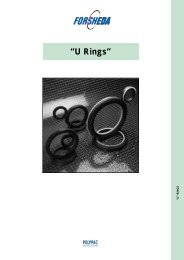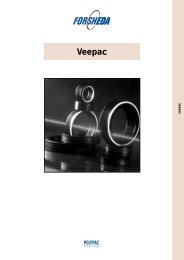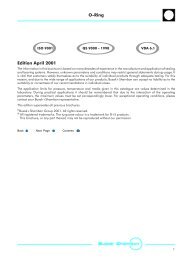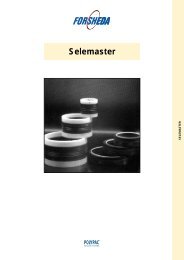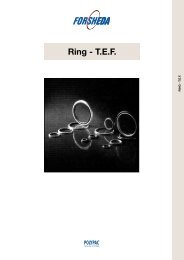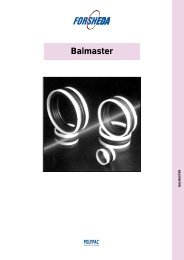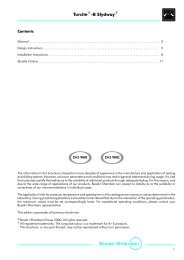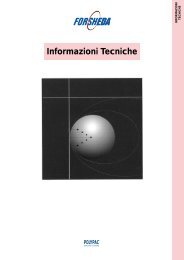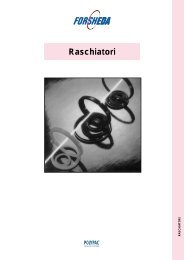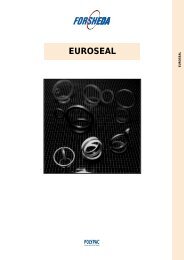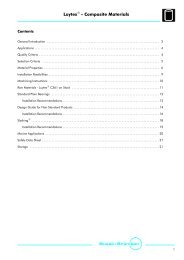Rotary Seals - Dilanda.it
Rotary Seals - Dilanda.it
Rotary Seals - Dilanda.it
Create successful ePaper yourself
Turn your PDF publications into a flip-book with our unique Google optimized e-Paper software.
Cassette Seal<br />
n Material<br />
Metal case<br />
The cases are normally stamped of cold rolled steel sheet,<br />
EN 10 130 - Fe P04. The high demands on the metal cases;<br />
high surface finish, free from scratches etc., calls for<br />
production in special tools.<br />
Compression spring<br />
For the spring, spring steel SS14 1774 - DIN 17223 - is<br />
normally employed. If resistance to corrosion is required,<br />
stainless steel SS 14 2331 - DIN 1.4301 - is used.<br />
Sealing element<br />
The material of the sealing element must be selected<br />
according to the working cond<strong>it</strong>ions of the seal and the<br />
environmental cond<strong>it</strong>ions.<br />
Some of the requirements associated w<strong>it</strong>h environmental<br />
considerations are:<br />
- good chemical resistance<br />
- good resistance to heat and low temperature<br />
- good resistance to ozone and weathering<br />
The functional demands include:<br />
- high resistance to wear<br />
- low friction<br />
- low compression set<br />
- good elastic<strong>it</strong>y<br />
In add<strong>it</strong>ion, cost considerations make good processabil<strong>it</strong>y a<br />
desirable feature.<br />
No material is available today, which satisfies all these<br />
requirements. The choice of material is therefore always a<br />
compromise between the relative significance of the<br />
factors involved.<br />
However, FORSHEDA has succeeded in developing a N<strong>it</strong>rile<br />
Rubber compound (NBR), which exhib<strong>it</strong>s good all-round<br />
properties, and for this reason <strong>it</strong> is the compound most<br />
commonly used.<br />
The materials normally used for the sealing element are:<br />
N<strong>it</strong>rile Rubber (NBR), Hydrogenated N<strong>it</strong>rile Rubber (HNBR)<br />
and Fluorinated Elastomers (FKM).<br />
The add<strong>it</strong>ional dirt seal is normally made of N<strong>it</strong>rile Rubber.<br />
N<strong>it</strong>rile Rubber is the basis material for cassette seals, as <strong>it</strong><br />
covers most standard application requirements for general<br />
oil- and grease resistance. It is from function and cost<br />
aspects the best choice when temperature is not excessively<br />
high.<br />
N<strong>it</strong>rile can be used up to 125°C in non-aggressive oils.<br />
However for long time use, or in aggressive oils, service<br />
temperature is reduced to 80°C.<br />
N<strong>it</strong>rile generally has good mechanical properties and the<br />
material used for cassette seals is optimised for best heat<br />
and abrasion resistance.<br />
Hydrogenated N<strong>it</strong>rile Rubber is a further development of<br />
NBR, where the chemical double bonds in the polymer<br />
molecules are saturated w<strong>it</strong>h hydrogen. Since the double<br />
bonds of NBR are sens<strong>it</strong>ive to heat and ozone, the HNBR<br />
will be superior to NBR in heat, ozone and weather<br />
resistance. It can generally be used up to 150°C in nonaggressive<br />
media, however for long time use maximum<br />
service temperature is 120°C.<br />
The HNBR for the cassette seal is fully saturated and thus<br />
well su<strong>it</strong>ed for use in aggressive oils. The temperature<br />
should however be lim<strong>it</strong>ed at 120°C. As saturated HNBR<br />
cannot be vulcanised w<strong>it</strong>h sulphur, the material has<br />
resistance to most hypoid oils up to about 120°C for long<br />
time use.<br />
Low friction and high abrasion resistance are add<strong>it</strong>ional<br />
typical features.<br />
Fluorinated Elastomers represents peak performance<br />
regarding heat and chemical resistance. They can be used<br />
up to 200°C for long time, and are generally very resistant<br />
to oil, grease and fuels. Ozone and weather resistance is<br />
outstanding.<br />
Mechanical and low temperature properties are however<br />
lower compared to N<strong>it</strong>rile. Thus Fluor elastomers should be<br />
considered only when the material properties are fully<br />
used. Some oil add<strong>it</strong>ives like amines and high pH-values<br />
may damage Fluoroelastomers, when used at high<br />
temperatures.<br />
Temperature resistance<br />
Increasing temperature accelerates the ageing of rubber,<br />
the elongation decreases, and the compression set<br />
increases and finally the material becomes hard and<br />
br<strong>it</strong>tle. Cracks at the sealing edge are a typical indication<br />
that the seal has been exposed to excessively high<br />
temperature. The ageing of the rubber has appreciable<br />
significance on the useful life of the seal. It can generally<br />
be said that a temperature increase of 10°C (in air) will half<br />
the theoretical useful life of the rubber. Low temperatures<br />
are generally not a big problem since the seals themselves<br />
generate heat by friction when rubbing against another<br />
surface. If the seal has been chilled down, <strong>it</strong>s original<br />
properties will return as soon as <strong>it</strong> is warmed up again.<br />
Some leakage may however arise during the start-up<br />
phase, before rubber material is softened by friction heat.<br />
138<br />
Latest information available at www.busakshamban.com<br />
Ed<strong>it</strong>ion April 2006



